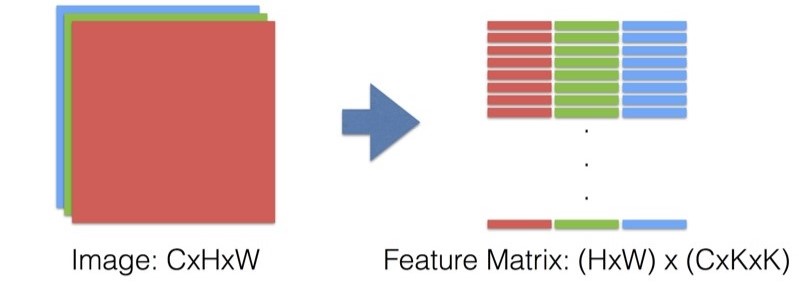卷积运算原理 与 模型FlOPs复杂度分析
概念
FLOPS:floating point operations per second的缩写,每秒浮点运算次数,理解为计算速度。是一个衡量硬件性能的指标。
FLOPs:floating point operations的缩写(s表复数),浮点运算数,理解为计算量。可以用来衡量算法/模型的复杂度。
FLOPs 计算公式
不考虑bias,只考虑滑动窗口中的k * k此乘法与k * k-1次加法运算 (batch size = 1)
(
2
∗
k
2
∗
c
i
n
−
c
h
a
n
n
e
l
−
1
)
∗
h
o
u
t
∗
w
o
u
t
∗
c
o
u
t
−
c
h
a
n
n
e
l
(2 * k^2 * c_{in-channel} - 1) * h_{out} * w_{out} * c_{out-channel}
(2∗k2∗cin−channel−1)∗hout∗wout∗cout−channel
考虑bias,z在上面的基础上 * 1 + bias
( 2 ∗ k 2 ∗ c i n − c h a n n e l + 1 ) ∗ h o u t ∗ w o u t ∗ c o u t − c h a n n e l (2 * k^2 * c_{in-channel} + 1) * h_{out} * w_{out} * c_{out-channel} (2∗k2∗cin−channel+1)∗hout∗wout∗cout−channel
tf.profiler.profile 提供的FLOPs计算API
( 2 ∗ k 2 ∗ c i n − c h a n n e l ) ∗ h o u t ∗ w o u t ∗ c o u t − c h a n n e l (2 * k^2 * c_{in-channel}) * h_{out} * w_{out} * c_{out-channel} (2∗k2∗cin−channel)∗hout∗wout∗cout−channel
简单的前向传播卷积实现
def conv_forward(feature, filter, bias, conv_param):
"""
:param feature: input batch image feature map, shape (batch, img_h, img_w, channel)
:param filter: implemented filter, shape (filter_num, filter_h, filter_w, filter_channel)
:param bias: biases, shape (filter_num)
:param conv_param: dictionary which contains 'pad', 'stride', ...
:return: output feature map
"""
batch, feature_h, feature_w, channel = feature.shape
filter_num, filter_h, filter_w, filter_channel = filter.shape
pad = conv_param['pad']
stride = conv_param['stride']
feature_pad = np.pad(x, ((0,0), (0,0), (pad,pad),(pad,pad)), 'constant')
feature_out_h = 1 + int((feature_h + 2 * pad - filter_h) / stride)
feature_out_w = 1 + int((feature_w + 2 * pad - filter_w) / stride)
feature_out = np.zeros((batch, feature_out_h, feature_out_w, filter_num))
for b in range(barch):
for f in range(filter_num):
for i in range(feature_out_h):
for j in range(feature_out_w):
feature_window = feature_pad[b, :, i*stride:i*stride+filter_h, j*stride:j*stride+filter_w].reshape(1, -1)
filter_vector = filter[f].reshape(-1, 1)
feature_out[b, f, i, j] = feature_window.dot(filter_vector) + bias[f]
cache = (feature, filter, bias, conv_param)
return feature_out, cache
优化
用矩阵乘法代替多重for循环




reference: https://www.zhihu.com/question/28385679
实际tensorflow模型FLOPs统计示例
tf.profiler.profile 统计tensorflow freezing graph FLOPs
import tensorflow as tf
from tensorflow.python.framework import graph_util
def load_pb(pb):
with tf.gfile.GFile(pb, "rb") as f:
graph_def = tf.GraphDef()
graph_def.ParseFromString(f.read())
with tf.Graph().as_default() as graph:
tf.import_graph_def(graph_def, name='')
return graph
# ***** (1) Create Graph *****
g = tf.Graph()
sess = tf.Session(graph=g)
with g.as_default():
A = tf.Variable(initial_value=tf.random_normal([25, 16]))
B = tf.Variable(initial_value=tf.random_normal([16, 9]))
C = tf.matmul(A, B, name='output')
sess.run(tf.global_variables_initializer())
flops = tf.profiler.profile(g, options = tf.profiler.ProfileOptionBuilder.float_operation())
print('FLOP before freezing', flops.total_float_ops)
# *****************************
"""
Flops should be ~ 7200
result: FLOP before freezing 8288
解析:变量通常会通过高斯分布进行初始化,引入额外的FLOPs,
而初始化一次性完成,并且在训练或推理期间都不会发生。
除此之外,一份完整的模型还会包括loss, learning rate, BN 等参数。
因此在真正统计模型FLOPs之前, 我们需要冻结模型,
在~/dist-packages/tensorflow/python/tools文件下
tensorflow有提供 freeze_graph.py, 可以方便的冻结训练模型,
移除与输出节点不相干的nodes
"""
# ***** (2) freeze graph *****
output_graph_def = graph_util.convert_variables_to_constants(sess, g.as_graph_def(), ['output'])
with tf.gfile.GFile('graph.pb', "wb") as f:
f.write(output_graph_def.SerializeToString())
# *****************************
# ***** (3) Load frozen graph *****
g2 = load_pb('path_to_your_freezing_graph')
with g2.as_default():
flops = tf.profiler.profile(g2, options = tf.profiler.ProfileOptionBuilder.float_operation())
print('after freezing: {} BFLOPs'.format(flops.total_float_ops / 1e9))
reference: https://stackoverflow.com/questions/45085938/tensorflow-is-there-a-way-to-measure-flops-for-a-model/50680663#50680663?newreg=384984a98356434bb936801d52714a46





















 3万+
3万+











 被折叠的 条评论
为什么被折叠?
被折叠的 条评论
为什么被折叠?








